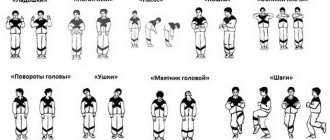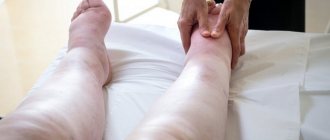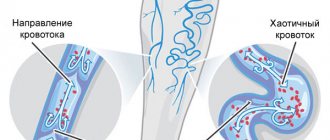The benefits of yoga for hypertension
Most doctors, along with medications, recommend yoga to their patients. Although hypertension is constantly getting younger, the majority of patients are elderly people who are prohibited from intense physical activity. Yoga for blood pressure is recommended by Ayurveda as one of the steps to a healthy life. Along with yoga techniques, they recommend eating right, completely giving up alcohol and smoking, and enriching yourself spiritually. From the point of view of Ayurveda, hypertension is a condition that develops as a result of constant stress, as well as prolonged blockage of the gastrointestinal tract and arterial vessels.
The impact of asanas is not limited to normalizing blood pressure. Yoga therapy has a positive effect on the entire body, improving the functioning of all organs and systems. It is especially important for hypertensive patients that individual exercises improve blood circulation and calm the central nervous system.
The practice is based on deep, calm breathing, which plays a primary role in normalizing blood pressure.
Types of yoga
Yoga has more than a dozen varieties, ranging from relaxation techniques to acrobatic forms. Not all exercises from oriental gymnastics will be beneficial in the treatment of hypertension. Patients should avoid asanas that stimulate blood flow to the heart and brain. The following poses are considered dangerous for people with hypertension:
- bhastrika;
- kumbhakas;
- kapalabhati.
It is important to exclude power asanas, not to be fixed in one position for a long time, and also to limit breathing exercises with short exhalations.
It is not recommended to perform inverted asanas - they can provoke an increase in blood pressure.
In a hypertensive patient, an inverted position will cause a rush of blood to the brain, rupture of blood vessels and even a stroke.
Techniques that activate the parasympathetic nervous system have a good effect on the body. They are completely safe and useful for people with hypertension.
Basic practices for hypertension:
- meditation techniques;
- Ujjayi;
- brahmari;
- candra-bhedana;
- yoga nidra;
- trataka.
A yoga therapist will help you decide on the type of yoga. In choosing the appropriate technique of oriental gymnastics, he will be guided by the degree of hypertension, age, physical fitness, as well as weight and other individual characteristics of the patient.
When should you not do yoga?
Yoga and hypertension can easily coexist. There are whole sets of exercises aimed at normalizing blood pressure. Yoga therapy is indicated for everyone, regardless of medical history and age. Hypertensive patients only need the selection of special techniques. Such people should warn trainers about health problems and train in separate groups.
The world of yoga consists of a huge number of asanas, differing in intensity and impact on the human body. Not all of them are allowed for hypertensive patients, as they can cause harm.
For patients who have recently suffered a serious illness or surgery, a special set of exercises is selected. They are easy to perform and do not create additional stress on the body. Particular attention is paid to patients with diseases of the joints and skeletal system. Their training is carried out with extreme caution.
Hypertensive patients are not recommended to use techniques that increase intracranial pressure and have a stimulating effect on the nervous system.
These techniques include:
- dynamic exercises that put a double load on the body;
- raising legs while lying down;
- breathing techniques based on short and quick breaths (Bhastrika, Kapalbhati);
- prolonged fixations of the body;
- deep body deflections.
Note! It is not recommended for hypertensive patients to perform inverted poses, as this increases the risk of blood vessel rupture .
If you experience severe facial flushing or rapid heartbeat during yoga practice, you should lie on your back and begin moderate belly breathing. Inhalations and exhalations are smooth and deep.
Hypertensive patients are recommended to exercise according to an individually designed program, which can be adjusted based on the results achieved.
Is it possible to exercise and what are the benefits?
Yoga is based on even breathing and slow, smooth human movements.
During the class, people learn to concentrate, relax their muscles and normalize their emotional state. A hypertensive person who practices yoga can remain calm even in stressful situations, preventing pressure surges. Practicing oriental gymnastics makes the patient less susceptible to psychological stress, which is one of the main causes of hypertension. During a yoga session, blood circulation improves, and accordingly blood pressure and stress on the heart muscle are reduced.
Regular exercise slows down the development of atherosclerosis by reducing blood cholesterol levels and heart rate.
Yoga classes help strengthen not only the cardiovascular system, but also the entire body.
Motivational practices strengthen muscles, increase the range of motion of joints, and also reduce chronic pain and promote the healing of fractures and dislocations. A gentle combination of stretching exercises improves blood circulation and the supply of oxygen and nutrients to all internal organs.
Basic principles of yoga for high blood pressure
Yoga and blood pressure are compatible, provided gentle exercises are performed. This yoga therapy is aimed primarily at relaxing the shoulder muscles and relieving tension from the spine. The thoracic region is also strengthened.
Yoga has a whole range of developed exercises that normalize the functioning of the nervous system.
Such techniques include:
- Breath of Brahmari;
- Ujjayi breathing techniques;
- relaxation Shavasana.
Thus, the recommendations for hypertensive patients are as follows:
- do not allow the body to be fixed in one position for a long time;
- stay in each position should increase gradually;
- perform exclusively gentle poses.
Hypertensive patients measure their blood pressure before and after exercise. If your blood pressure increases after practicing yoga, it means that the wrong exercises are involved in the complex, or they are performed incorrectly. In this case, the trainer monitors the tactics of performing the exercises and, if necessary, changes the exercises.
Let's look at the main techniques used to lower blood pressure:
- Kneel down, palms extended, resting on the floor. The body stretches smoothly, the forehead should touch the floor. Be sure to control your breathing.
- The next exercise is performed while sitting on the floor in the lotus position. The back is straight. Breathing by alternately closing the nostrils with the index finger. First, one nostril closes - inhale and exhale, then the other. Do 5 times with each nostril.
The impact of yoga
The entire philosophy of yoga is aimed at teaching a person practicing such classes to listen to his body. This is not just a set of exercises, it is a whole system, including nutrition and the organization of the entire lifestyle.
Don't tolerate high blood pressure
Now hypertension can be cured by restoring blood vessels...
>
Firstly, yoga is associated with meditation. And meditation is a very effective way to deal with stress. A person who knows how to meditate is able to quickly overcome negative emotions and get rid of stress. Moreover, this practice helps prevent stress from occurring at all.
Secondly, she preaches moderation and abstinence. And these principles resonate well with the basics of proper nutrition, when a person limits the consumption of harmful foods.
Yoga can help reduce blood pressure by helping a person regain weight and eat right.
And thirdly, yoga is an exercise that does not include sharp, strenuous exercises. Therefore, even if you are very overweight, you can choose a complex. If active physical activity with high blood pressure is prohibited, then with the help of yoga you can bring your body back to normal.
Techniques for treating hypertension
Yoga against hypertension is a whole set of exercises aimed at normalizing blood circulation and relaxing muscles.
All of them are easy to perform and quite effective:
- Shavasana. The exercise consists of alternating leg raises for two minutes. Inhalations and exhalations are calm, deep, even.
- Corpse pose. This unattractive posture is very effective for high blood pressure. The essence is to raise and tilt your arms behind your head as you inhale, and return them to their original position as you exhale. The exercise is performed lying on your back, with complete relaxation.
- Sit on your buttocks, legs extended forward. As you exhale, reach your feet with your hands and hook them onto your toes. Try to reach your chest as far as your legs as possible, this will stretch the spine. At the very beginning, it will be difficult to do the exercise, so you can bend your knees slightly, gradually striving for full alignment.
Breathing techniques
Breathing techniques are useful even at very high blood pressure. Hypertensive patients are recommended to alternate nostril breathing, as well as slow inhalations and exhalations through the nose. A cycle of breathing practices normalizes blood pressure, relaxes and fills with energy.
Meditation
For patients with high blood pressure, meditation and breathing practices are especially useful. After just a few cycles of exercise, patients feel significantly better. This is expressed by stabilization of blood pressure, a surge of strength and energy, and a good and cheerful mood. But it must be remembered that physical activity, even the most minimal, must be performed under the supervision of a trainer. Especially exercises like purna or shodhana.
Mudra that lowers blood pressure
The body is as relaxed as possible, hands on the stomach. It is important to concentrate and imagine how the whole body is filled with energy and light. Then interlace all fingers except the thumbs and index fingers. First, the little fingers are connected to each other, then the ring fingers and finally the middle ones. The index finger of the right hand is straightened and moved to the side, the index finger of the left hand is pressed against it. The thumb on the left hand is moved to the side. Several repetitions reduce blood pressure and increase energy.
Asanas
The following asanas are aimed at normalizing the functioning of the nervous system and stabilizing blood pressure:
- Paschimottanasana. The essence of the asana is smooth bending forward. The practitioner sits on the floor and straightens his legs. As you exhale, you need to slowly reach your toes, fix the position for 2-3 minutes, and then return to the starting position. It is important to keep your knees straight.
- Halasana. Pose lying on your back with straightened legs and arms extended along the body. As you exhale, gently pull your knees toward your stomach, lifting your pelvis off the floor. With the help of your hands, your legs are thrown over your head, while your toes touch the floor. This position is held for 3 minutes, after which the starting position is smoothly returned. If you can’t do the exercise right away, you can put a pillow behind your head and lower your legs on it. This will make performing the asana a little easier.
Exercises for high blood pressure
Hypertension and yoga exercises cannot always complement each other; only some are suitable for normalizing blood pressure.
During training, you must strictly adhere to the rules of performing movements, which are called asanas. The complex also includes pranayama (from the Sanskrit “prana” - vital energy, breathing and “yama” or “ayama” - stopping, control or accumulation, connection).
Yoga for high blood pressure includes asanas and breathing exercises. Control of inhalation and exhalation allows you to change the concentration of oxygen and carbon dioxide in the blood.
Ayurveda recommendations
Ayurveda is a technique based on treatment with medicinal herbs. Indian sages used it in ancient times to treat hypertension. But it is worth clarifying that the technique is effective only in the first stages of the disease.
Despite the effectiveness of Ayurvedic treatment, it remains too complex for many. To eliminate a disease, Ayurveda initially establishes its cause.
First of all, Ayurvedic techniques are aimed at improving the functioning of the entire body, namely:
- normalization of the nervous system;
- removal of toxins from cardiac tubules;
- balancing the mind.
All this can be achieved through relaxation.
Pashtimottanasana (torso bends and back stretches)
Strengthens the abdominal muscles, enhances the performance of internal organs, stretches the spine and legs, strengthens the nervous system, stimulates processes associated with digestion, facilitates bowel movements, strengthens the kidneys and massages the heart muscle. Additionally activates and fills with energy.
Performing the asana step by step
- Sit on the floor. Straighten your legs and keep them together.
- Raise your arms above your head and tilt your torso slightly away from the vertical position.
- Very slowly bend your spine forward in a circle-by-circle manner.
- When you bend low enough, wrap your palms around your legs around your knees.
- Place your elbows out to the sides and press your torso towards your legs as much as you can (without using force, this will become easier over time).
- Straighten up slowly, one circle at a time. Repeat the exercise twice.
Yogi diet
It has long been proven that nutrition has a huge impact on the regulation of blood pressure. Yoga classes are more beneficial if they are complemented by proper nutrition. That is, a complete rejection of meat and animal products.
The diet of hypertensive patients is based on fresh fruits, vegetables, and whole grains.
Clinical studies have shown that people who do not eat meat rarely suffer from hypertension. Yogis are confident that a diet based on whole grains, fresh fruits and vegetables, by itself, lowers blood pressure by 15 mm Hg. Art.
Yoga for hypertension
Many people mistakenly believe that with high blood pressure, sports and any physical activity are contraindicated, and the best treatment and recovery is rest. This belief is true when people start training too vigorously without any preparation. With hypertension, a positive effect is achieved only by gradually increasing physical activity, which involves certain muscle groups. And yoga can provide such a load.
Yoga for high blood pressure is developed taking into account the understanding of the characteristics of the disease and the needs of the body.
Exercises to lower blood pressure can be done at any time of the day if the following conditions are met:
- Feeling good;
- Several hours passed after eating;
- No urge to go to the toilet;
- The training takes place in a calm environment;
- After each exercise, about 10 seconds are allotted to restore breathing;
- You can take a shower no earlier than 15 minutes after gymnastics.
Yoga classes to normalize blood pressure also have some limitations:
- You cannot perform asanas that require a shoulder or headstand;
- You cannot perform asanas that require strong arching of the back and raising of the legs from a sitting position.
If the pulse noticeably increases while performing asanas, you should stop exercising.
To restore normal functioning of the cardiovascular system, breathing and blood pressure you need:
- Lie on your back;
- Close eyes;
- Relax;
- Focus on breathing and heartbeat;
- Take several smooth and deep breaths in and out.
Exercises contraindicated for hypertension
Hypertensive patients perform inverted asanas with caution. Sharp bending of the body and stopping breathing are completely excluded. Such techniques worsen the well-being of hypertensive patients. Although many yoga therapists note in their practice that soft inverted poses help reduce blood pressure. But only if we are talking about mild hypertension. Therefore, patients with high blood pressure are recommended to gradually increase fixations and leg lifts.
In any case, inverted poses should be treated with extreme caution. If after a cycle of such exercises patients feel well and their blood pressure does not fluctuate, then such exercises are beneficial and do not threaten health.
If hypertension is unstable, and the patient has a history of a stroke, then inverted asanas will have to be completely abandoned. The same applies to deep arches in the back. It is better for hypertensive patients to exclude them.
Yoga is only useful if the practice is natural. Excessive tension makes it difficult to concentrate, so gradually the body must relax more and more. Thus, the main task of a hypertensive patient is to normalize breathing and complete relaxation when doing yoga.
Yoga is also useful
With constant and slow yoga practice, your body will begin to react differently to external stimuli, resistance to stress and excessive loads will appear and there will be:
- expand the shoulder muscles;
- headache and dizziness go away;
- dilate blood vessels;
- improve mood;
- strengthen the chest, as well as veins and arteries;
- relax the muscles of the whole body;
- calm the nervous system;
- relieving stress and tension on the cervical spine.
In the fight against hypertension, you can (and should) perform the following asanas:
- Pastimottanasana.
- Baddha konasana.
- Savasana.
- Five-pointed star.
- Semicircle pose.
- Surya bhedana pranayama.
Lifestyle of a person with hypertension according to yoga
Hypertension is a dangerous disease that requires a complete revision of your usual lifestyle. Yoga is only a small part of what a person can do to save his health. First of all, you need to reconsider your diet, give up meat and animal products. If this is difficult to do, at the first stage you can at least reduce their consumption.
It is important for hypertensive patients to lead a healthy lifestyle. Tobacco smoke and alcohol have an extremely negative effect on the heart and blood vessels. If not to say that they are generally incompatible with hypertension.
Hypertensive patients perform any exercise under supervision. Independent exercises are allowed only if a person is fully aware of the specifics of their implementation and does not create unnecessary stress on his body.
Equally important are frequent walks in the fresh air, a positive attitude and spiritual harmony. This is what yoga actually leads to.
Basic recommendations for combating hypertension
One of the most common diseases is hypertension. And although many people try to make a similar diagnosis for themselves, this should never be done.
Hypertension is a disease, and the diagnosis must be made by a doctor based on a number of medical indicators.
But once the diagnosis is made, a person has to adapt his entire lifestyle in order to remove any factors that may provoke an increase in blood pressure. Therefore, among the main recommendations given by the doctor are the following:
- Bringing weight back to normal. It is a proven fact that excess body weight increases blood pressure. The main criterion here is waist circumference: the larger it is, the higher the risk of hypertension.
- Sports activities. Properly organized physical activity is the most effective way to lose weight. In addition, sports helps strengthen muscles, instill healthy habits and generally improve the quality of life.
- Proper nutrition. Healthy and natural foods, less fast food, sweets and fatty foods - these are the main recommendations, but in general, the system of proper nutrition is organized somewhat more complicated.
- Reducing salt intake, which retains fluid in the body, stimulating the appearance of swelling.
- Drink alcohol and coffee in limited quantities.
- Reducing the stress load on the body.
If we talk about various recommendations for building a healthy lifestyle, then yoga meets all of the above requirements very well.
Yoga to normalize blood pressure
To stabilize blood pressure, they perform a set of exercises developed by yoga therapists specifically for hypertensive patients. The main task in this case is the balance between exercise and overexertion. The second option is unacceptable for hypertensive patients.
There are many types of yoga, each of which has its own characteristics and set of exercises.
Hypertensive patients can practice the following areas of yoga:
- Jnana.
- Hatha.
- Bhakti.
- Rajah.
- Karma.
Mudras
Mudra is an eastern practice that uses the energy channels of the hands, which contributes to the correct distribution of human vitality.
The techniques described below help normalize blood pressure , which is very important for hypertension.
If at the beginning of practice you cannot perform an exercise, it is recommended to exclude it from the workout and return to it later. ATTENTION! To avoid hand fatigue, it is necessary to master mudras gradually.
Simple mudra
It is necessary to fold your fingers into a lock so that the little finger of your right hand is on the outside, then you need to raise your index fingers, and pull your thumbs towards you.
Next you need to bend your left index finger. The thumb of the right hand must be bent so that it is in circumference with the left index finger.
The right thumb should remain extended.
Life Saving
This mudra is performed with both hands simultaneously. The index finger must be bent so that its pad touches the base of the thumb. Place the pads of the thumb with the pads of the middle and ring fingers.
The little finger is straightened. The exhalation should be slow and long, warming the space.
It is best to perform this exercise while sitting with your eyes closed and your hands on a horizontal surface.
Turtle
The fingers should be crossed, the thumbs extended upward parallel to each other and closely touching the side surfaces.
Breathing is calm, body is relaxed.
Vajra Arrow
The fingers are intertwined. The index fingers extended upward should touch the pads. The thumbs are straight, extended upward, connected by the lateral surfaces. Breathing is smooth and calm. This position must be maintained for 15 minutes.
Legendary meditation course without payment We recommend! The most popular meditation course for beginners in Russian. More than 100 thousand people have already learned to meditate. Try it yourself. Read more.
Shakyamuni hat
The index and ring fingers should be bent, and the pads of the little and middle fingers should be joined. The thumbs, pressed against the side surfaces, must be kept straight and the top extended.
Knowledge
You need to place your hands on any horizontal surface with your palms facing up. It is easy to connect the pads of your thumb and index finger without pressing.
This exercise is performed with both hands simultaneously 5-6 times a day for 5-10 minutes. Important! To achieve maximum effect, it is advisable to focus on a blue background and turn your face to the east.
Earth
It is necessary to combine the pads of the thumb and ring fingers with little effort, the phalanges of the remaining fingers should be straightened. Performed on both hands at once. To increase effectiveness, you need to inhale the aroma of mint essential oil.
Water
With the thumb of the right hand, it is necessary to hold the right little finger in a bent position so that its pad touches the base of the thumb. With your left hand, clasp your right hand from below so that the thumb of your left hand lies on top of the crossed fingers of your right hand.
Life
The pads of the little finger, ring finger and thumb should be connected, and the index and middle fingers should be straightened.
It must be remembered that by influencing the body in a comprehensive manner, it is possible to achieve normalization of blood pressure much faster. Therefore, mudras must be combined with breathing and meditative techniques or therapeutic exercises.
Yoga for low blood pressure
Yoga is also indicated for patients with low blood pressure. Classes are held in the first half of the day.
If in case of hypertension it is better to abstain from inverted poses, then in the case of hypotension people the opposite is true. Exercises in a standing position and breathing practices are also useful, allowing you to increase your heart rate and increase blood pressure.
Before starting yoga therapy, patients suffering from changes in blood pressure undergo a consultation with a doctor. Depending on the severity of the disease, yoga is considered as an independent method of treatment or as an addition to drug therapy.
Preventive exercises to normalize blood pressure
The combination of these asanas triggers the body’s self-regulation and normalizes blood pressure. It is recommended to perform this complex three times a week.
- Five-pointed star . The back is straight, the legs are wider than the shoulders, the arms are spread out to the sides parallel to the floor. The back of the head stretches upward, and the arms and legs are as straight as possible. Next, you need to perform 6 breathing cycles: alternating a slow deep breath with a smooth exhalation.
- Semicircle . You need to kneel down and move your right leg to the side so that your foot touches the floor. The left palm should be placed on the floor and the right palm should be extended upward. You need to do it in turn for each side, holding the pose for about a minute.
- Puppy . You need to kneel and then sit so that your buttocks are higher than your feet. Next, you need to touch the floor with your hands and extend your palms as far as possible.
- Table . You need to focus on your knees and palms, and then stretch your right hand forward, your left foot back.
- Cat . Focus again on your knees and palms. As you inhale, you need to raise your head up and arch your back down as much as possible, and as you exhale, lower your head and round your back.
REFERENCE! It is advisable to perform yoga exercises in the first half of the day.
Exercises to lower high blood pressure
A person of any age, wanting to lower blood pressure, can do yoga by choosing suitable asanas for himself.
Corpse pose is considered the most important pose. It is very important to learn how to do it correctly:
- lie on your back so that your back is as close to the floor as possible;
- stretch your arms along your body, palms up, fingers slightly bent, eyes closed, feet shoulder-width apart, feet turned to the sides;
- you should feel relaxed in your body;
- relax first the left, then the right shoulder, forearms, elbows, wrists and finally the fingers;
- relax your hips and pelvis, abdominal muscles, chest area, back;
- Even out your breathing, inhale and exhale through your nose.
The exercise can be considered completed if the person feels the full weight of his weakened torso. It takes approximately half an hour to complete. It is worth repeating twice a day: after waking up and before going to bed. It won't hurt to go to the toilet beforehand.
Pavanmuktasana - this type of asana should be repeated 5 times a day. Technique:
- lie on your back, stretch your arms along your body, look straight;
- bend the right leg and pull it towards the chest;
- move your right hand to your ankle, place your left hand on your knee;
- press your knee to your chest for 7–10 seconds;
- take the starting position;
- do the exercise with the other leg.
Uttanpadasana - involves raising the legs. People with spinal column pathologies should avoid this pose. Execution order:
- lie on your back, stretch your arms along your body, palms facing the floor, legs straight, closed;
- take a deep breath and hold your breath for a few seconds. At this time, raise the left leg by 20–25 cm and hold it for 5 seconds, lower it, and with each subsequent approach, increase the holding time by 1 second (the recommended number of approaches for each leg is 4–5);
- change legs and repeat the exercise.
Santulanasana - requires the following steps:
- put a blanket on the floor, stand straight on it, look straight, relax your arms (it is better to be near the wall so that there is support if it is difficult to stand on one leg);
- stand on your left leg, bend your right knee so that your heel is as close to your buttocks as possible;
- With your right hand, completely clasp your toes and further pull your leg towards your thigh;
- after, tense your left hand, slowly raising it up with your palm towards the floor, when lifting it up, point your palm up;
- hold in this position for 7–10 seconds, keep your left leg and arm tense, breathing should be even;
- gently lower your left hand without releasing the tension;
- place your right foot on the floor;
- rest for 8 seconds and do everything again with the other leg.











